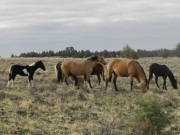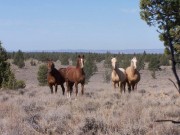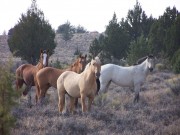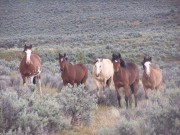History of the Mustang
Wild, free, running, beauty, strength, endurance, MUSTANG.
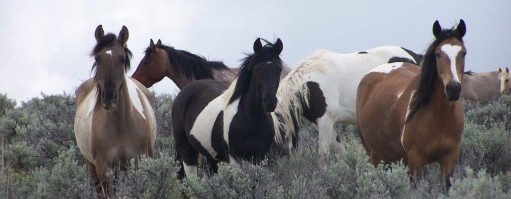
The words that come to mind when thinking about America’s Wild Horse paints a picture that many today think only existed back in the days of the Wild West. America’s Wild Horse and Burro populations however are very much still present today. So much in fact, that we are faced with a new dilemma of over- population and an urgent need to find these majestic beauties forever loving homes.
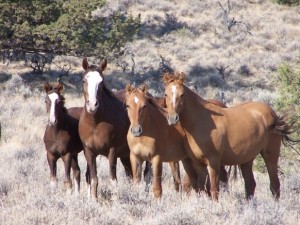 In 1971, the United States Congress recognized Mustangs as “living symbols of the historic and pioneer spirit of the West, which continue to contribute to the diversity of life forms within the Nation and enrich the lives of the American people.” Today, Mustang herds vary in the degree to which they can be traced to original Iberian horses. Some contain a greater genetic mixture of ranch stock and more recent breed releases, while others are relatively unchanged from the original Iberian stock, most strongly represented in the most isolated populations.
In 1971, the United States Congress recognized Mustangs as “living symbols of the historic and pioneer spirit of the West, which continue to contribute to the diversity of life forms within the Nation and enrich the lives of the American people.” Today, Mustang herds vary in the degree to which they can be traced to original Iberian horses. Some contain a greater genetic mixture of ranch stock and more recent breed releases, while others are relatively unchanged from the original Iberian stock, most strongly represented in the most isolated populations.
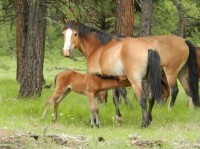 The Mustang population is managed and protected by the Bureau of Land Management. Controversy surrounds the sharing of land and resources by the free ranging Mustangs with the livestock of the ranching industry, and also with the methods with which the federal government manages the wild population numbers. There are over 180 different Herd Management Area’s (HMA) in 10 western states in the U.S. costing the government over $75 million per year to feed and care for.
The Mustang population is managed and protected by the Bureau of Land Management. Controversy surrounds the sharing of land and resources by the free ranging Mustangs with the livestock of the ranching industry, and also with the methods with which the federal government manages the wild population numbers. There are over 180 different Herd Management Area’s (HMA) in 10 western states in the U.S. costing the government over $75 million per year to feed and care for.
Oregon Herds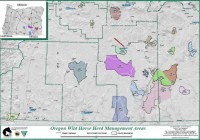
- 19 Herds Roaming Wild in Oregon Alone
- 17 managed by BLM (2.7 million acres BLM)
- 1 Wild Horse Territory co-managed by BLM (25%) & USFS (75%)-Murderers Creek
- 1 Wild Horse Territory managed solely by USFS-Big Summit
- Oregon’s populations reached their population numbers back in the 1980s to where they could live healthy without destroying the range-lands or running low on water resources.
- To preserve this population the BLM selects the best horses to be turned back on the range to produce the next generation of horses for our adopters based on temperament, size, color & conformation.
- Our populations double though every 4 years creating an increasing number of horses needing adoption.
National Population Statistics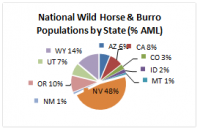
- 10 States currently have wild horses and/or burros: AZ, CA, CO, ID, MT, NM, NV, OR, UT, WY
- There are 187 HMAs in the 10 western States.
- 26.9 million BLM acres w/in HMAs
- National AML of 26,500 horses & burros
- Current national estimate of 40,600 horses & burros on the range
- Long-term Pastures house many of the over populated horses that have not been adopted
- 23 Private facilities in OK, KS and SD
- 1 Private land “Eco Sanctuary” in WY
- 1 Private/Public Land “Eco Sanctuary” proposed in NV
- Approximately 50,000 wild horses in short and long-term holding.
About the Mustang Heritage Foundation
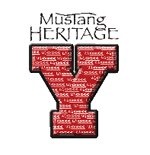 The mission of the Mustang Heritage Foundation and the goal of the event is to increase the adoption of mustangs across the country. The Mustang Heritage Foundation supports this and other events of their own creation to showcase the recognized value of mustangs through a training competition and has placed thousands of mustangs for adoption since September, 2007. Go to: www.mustangheritagefoundation.org for more information.
The mission of the Mustang Heritage Foundation and the goal of the event is to increase the adoption of mustangs across the country. The Mustang Heritage Foundation supports this and other events of their own creation to showcase the recognized value of mustangs through a training competition and has placed thousands of mustangs for adoption since September, 2007. Go to: www.mustangheritagefoundation.org for more information.
About the Bureau of Land Management (BLM)
Wild Horse and Burro program
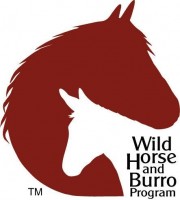 The Bureau of Land Management (BLM) is responsible for managing 258 million acres of public lands, located mostly in the West. Wild horses and burros roaming public rangelands are managed in a manner consistent with BLM’s overall multiple-use mission, as set forth in the Federal Land Policy and Management Act of 1976. Since 1973, the BLM has placed more than 219,000 horses and burros into private care through adoption. For more information, visit: www.blm.gov/or/resources or call 866-4MUSTANGS.
The Bureau of Land Management (BLM) is responsible for managing 258 million acres of public lands, located mostly in the West. Wild horses and burros roaming public rangelands are managed in a manner consistent with BLM’s overall multiple-use mission, as set forth in the Federal Land Policy and Management Act of 1976. Since 1973, the BLM has placed more than 219,000 horses and burros into private care through adoption. For more information, visit: www.blm.gov/or/resources or call 866-4MUSTANGS.

